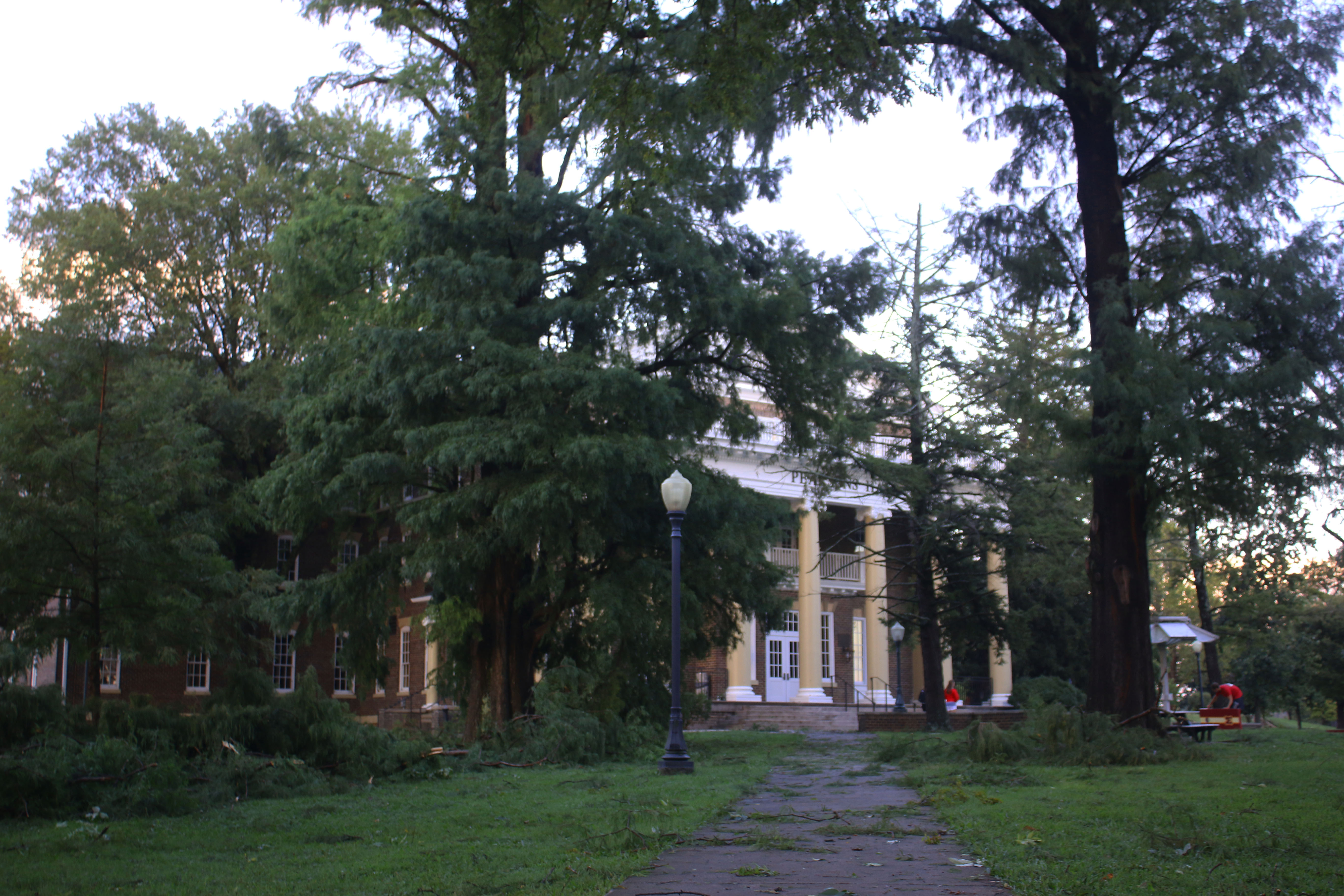Maryville College community reacts to severe weather

On the evening of Aug. 27, Maryville College’s campus experienced a severe thunderstorm. Extensive tree damage, flooding, wind damage and a prolonged power outage all resulted from the brief but treacherous storm. Minutes after the storm ended, students and faculty gathered outside to immediately began assessing the damage done to campus. While the school is thankful no one was hurt, the whole ordeal has encouraged students to stop and consider the implications inclement weather can cause.
The idea of disastrous weather strikes discomfort in most, so the college’s storm plan is not a topic discussed regularly for students. Fire drills and building safety codes are maintained and kept in order, but it’s the rare and extreme cases of disastrous weather that leave students to react without immediate instruction.
“We have a very detailed crisis management plan, with 25 protocols for different emergencies regarding any kind of crisis,” said chairman of the college’s Crisis Management Team Vandy Kemp.
However, because the college has never experienced a severe windstorm such as this, there was no specific protocol to follow.
“I immediately called other members of the team to confirm any reports of injuries or damage,” Kemp said. “We heavily relied on the support of our residence life staff doing ground checks on their buildings and reporting that everyone was safe.”
In the wake of the storm, physical plant workers, professors and students alike were out attempting to clean the storm’s damage. Physical plant director Andy McCall and campus security were in contact with each other to quickly assure the safety of students and the access of roads.
Despite the extremely severe storm, campus was incredibly busy. Immediately people lined the sidewalks and green spaces, surveying damage and picking up sticks. Professors and students, some of whom were not on campus when the storm happened, quickly showed up to help in any way. While the help of others not on campus was appreciated, the risk of bringing more people to campus was one reason why IRIS never went off.
“We only implement the IRIS call when we feel it’s absolutely necessary,” Kemp said. “In the case of this particular windstorm, we did not want to issue an IRIS call that would potentially bring more people onto campus.”
Nick Peterson, Student Body President, was one of the students who immediately began assessing the damage done to campus. He, along with other students, moved around campus in the minutes after the storm.
“Seeing everyone out helping was very inspirational for me,” said Peterson. “It’s our campus and we should be the first people who want to take care of it.”
The damage done to campus quickly influenced social media as well, with the hashtag “#ripmaryville” becoming a favorite among students posting footage of the damage on Facebook, Snapchat and Instagram. Selfies with fallen limbs, flooded fields and even displaced gutters became the ideal social media fillers following the hours after the storm.
As the sun set and campus became eerily dark, freshmen who had just moved onto campus got to experience a whole new way to bond.
“There were lots of stories of monopoly and other group games being played in the dark,” Kemp said.
Through the calm nature of the staff, the outage became less of a frightening disaster and more of a cozy way to bond with building residents.
However, for some buildings on campus, simply turning the power back on was not a solution to fixing its issues. David Rasnake, the technical director for The Clayton Center for the Arts, immediately began assessing the implications that a prolonged power outage can cause.
“We have response procedures immediately following a power outage to ensure all emergency lighting systems are working, and that the building is secure,” Rasnake said. “Like many buildings on campus, the CCA goes into lockdown during an extended power outage. Once we had determined that there were no students still in the building, we knew it would remain secure during the outage.”
Unfortunately because the outage was so long and the power did not come back on in Clayton until 4 in the morning, Rasnake spent the early hours of the morning bringing the dimmer racks back online for the lighting system. Thankfully, there was enough time to restore the system and still have the annual worship service on Sunday morning.
“The important thing is, we learned where there are gaps and are working on plugging those gaps for the next time this happens,” Kemp said. “I’m really proud of the community for the whole attitude of ‘what needs to happen next’ during the whole ordeal.”
While it’s rare to have such damaging storms, there is still a chance they could happen. Maryville students were concerned about the state of their campus immediately following the storm, but the quickness of the damage truly did catch everyone by surprise.
The total blowdown of trees came quickly, and the campus was very lucky there were no injuries or major damage to buildings. The community is extremely thankful that no one was injured because of the storm, the school urges the students to remember the policy following inclement weather and to know that the school is prepared to keep students safe, regardless of the crisis or situation.


